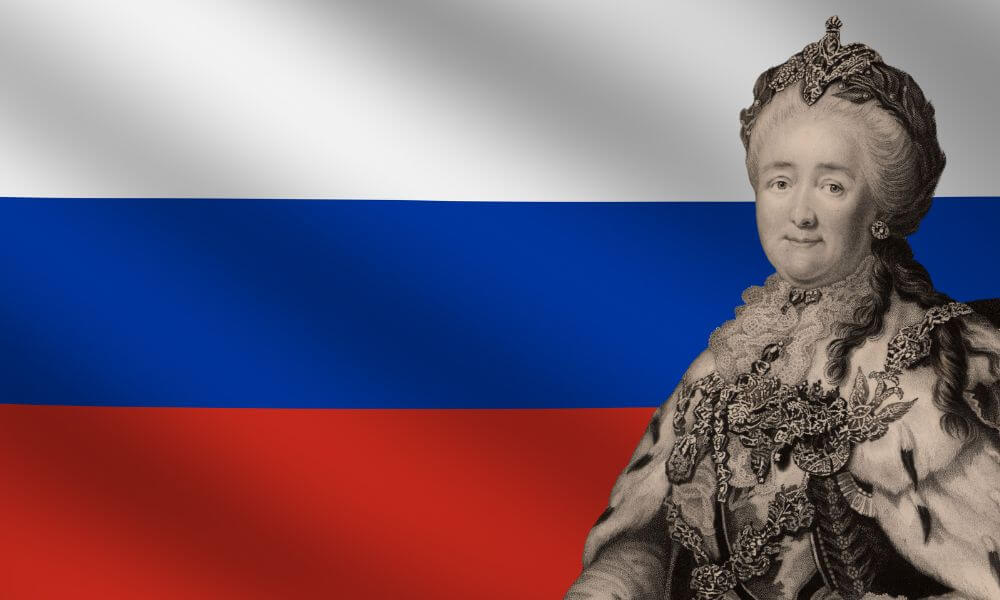Catherine the Great, who lived from May 1729 to November 1796, was the last Empress of Russia. She ruled for 34 years from 1762 up until her death, making her the longest serving Emperor or Empress in Russia’s history. She was born in Prussia (Germany) and thus spoke German growing up. Given her rule of Russia, she was fluent in Russian while French was also part of her education.
The three languages Catherine the Great spoke were all Indo-European languages, meaning they shared a common ancestor.
This ancestor was known as Proto-Indo-European or PIE for short.
Despite this common ancestor, the three languages all branched off from different language families.
Russian came from the Balto-Slavic family, French came from the Romance Language family and Germany came from the Germanic family.
The early forms of all three languages came into existence around the same time.
Old Russian, also known as Old East Slavic, was spoken from the 8th century to the 15th before breaking up into the wider Slavic languages.
Old French was spoken from the 8th century to the 14th century and is a Langue D’oil.
Old High German was spoken from the 8th century to the 12th century before giving way to Middle High German.

What Language was Spoken in the Russian Court?
French was the language of Russian Court, hence the requirement for Catherine the Great to learn it.
It became the language of politics and nobility in Europe and high-ranking Russians required it in order to move in the highest of circles, form relationships and communicate with European counterparts.
What are the East Slavic Languages?
East Slavic languages are one of three regional subsets of Slavic languages.
The other two are the South Slavic and West Slavic language families.
East Slavic by far outweighs South and West Slavic both in the number of languages and number of native speakers.
The most common languages stemming from the East Slavic language family are Russian, Belarusian, Ukrainian, and Rusyn.
From the latest census numbers for each country, it can be determined that 154 million people claim Russian as their primary language, 40 million speak Ukrainian, 5.1 million speak Belarusian and only around 76 thousand speak Rusyn, a number reached following an amalgamation of figures from Slovakia, Serbia, Poland, Ukraine, Croatia, Hungary and the Czech Republic.
What are the Romance Languages?
The Romance languages are those stemming from Vulgar Latin, a language spoken from the Late Roman Republic onwards.
While there are many Romance languages with a total of over 900 million native speakers, five, in particular, that stand out.
Along with French, which has 79.9 million native speakers, other Romance Languages include Spanish (475 million native speakers), Portuguese (232 million native speakers), Italian (64.8 million speakers) and Romanian (24 million speakers).
These languages are mainly spoken in Europe, South America and parts of Africa.
What are the Germanic Languages?
The Germanic languages are primarily spoken in Europe, South American, North America, Oceania and Southern Africa.
They boast around 515 million Native Speakers made up of a variety of languages.
These languages include English, German, Dutch, Swedish, and Afrikaans among others.
English is the world’s most spoken language with over 2 billion speakers, however, only 373 million of these can claim to be native speakers.
75.6 million speak German natively while the figures are much lower for Dutch, Swedish and Afrikaans, coming in at 24 million, 11.1 million and 7.2 million respectively.
How Many People Speak German?
Today German is spoken by 75.6 million people natively and around 85 million have it as their L2 or second language.
6 countries have German as their official language: Germany, Austria, Switzerland, Belgium, Liechtenstein and Luxembourg.
A further 9 countries recognize it as a minority or national language.
This list includes Brazil, Czech Republic, Denmark, Hungary, Italy, Namibia, Poland, Romania, Russia and Slovakia.
There are 3 standardizations variations of the language: German, Austrian and Swiss Standard High German though the German standard is by far the most dominant of the three.
The German alphabet has between 26 and 30 letters, depending on what is counted as a letter.
Similar to English, German has 26 regular letters in its alphabet, A-Z. It also has three umlauts (Ä, Ö, Ü) and a ligature (ß).
In Switzerland and Liechtenstein, the ligature (ß) is not present and is instead written as ss.
How Many People Speak Russian?
Russian is spoken by 154 million people natively and 110 million people claim it as their L2.
It is the Official Language of 5 UN Member States: Russia, Belarus, Kazakhstan, Kyrgyzstan and Tajikistan and maintains official language status in a number of other partially recognized states and regions.
Russian is recognized as a minority language in a further 9 countries: China, Romania, Armenia, Poland, Czech Republic, Slovakia, Moldova, Mongolia and Ukraine.
The Russian alphabet is written using the Cyrillic script which was devised in the 9th century for the first Slavic language.
In total, the Russian alphabet has 33 letters: 20 consonants, 10 vowels, a semivowel and two modifier letters.
How Many People Speak French?
French is spoken by 79.9 million people natively and another 244.2 million claim it as a second language.
French is the official language of 29 countries worldwide.
This list is made up of: Belgium, Benin, Burkina Faso, Burundi, Cameroon, Canada, Central African Republic, Chad, Congo, Comoros, Democratic Republic of Congo, Djibouti, Equatorial Guinea, France, Gabon, Guinea, Haiti, Ivory Coast, Luxembourg, Madagascar, Mali, Monaco, Niger, Rwanda, Senegal, Seychelles, Switzerland, Togo and Vanuatu.
The French alphabet features 26 letters, 5 diacritics and 2 ligatures. Diacritics include the acute accent, the grave accent, the circumflex, the cedilla and diaeresis.
Catherine the Great was the last and longest ruling Empress of Russia.
She was a polyglot and spoke German, Russian and French. Each of these languages comes from the Indo-European languages family and together they have a combined total of over 265 million native speakers.
More in Languages
- What Language Did Abraham Speak? (Explained!)
- What Language Did Adam And Eve Speak? (Answered!)
- What Language Did Albert Einstein Speak? (Wunderbar!)
- What Language Did Alexander The Great Speak? (Answered!)
- What Language Did Anne Frank Speak? (It May Surprise You!)
- What Language Did Beethoven Speak? (Revealed!)
- What Language Did Boudicca Speak? (Explained!)
- What Language Did Bruce Lee Speak? (Answered!)
- What Language Did Catherine The Great Speak? (Answered!)
- What Language Did Cavemen Speak? (Explained!)
- What Language Did Christopher Columbus Speak? (Answered!)
- What Language Did Cleopatra Speak? (Explained!)
- What Language Did George Washington Speak? (Revealed!)
- What Language Did Jesus Speak? (Answered!)
- What Language Did Julius Caesar Speak? (Find Out!)
- What Language Did Moses Speak? (Answered!)
- What Language Did Mozart Speak? (Answered!)
- What Language Did Noah Speak? (Explained!)
- What Language Did The Anglo Saxons Speak? (Answered!)
- What Language Did The Aztecs Speak? (Answered!)
- What Language Did The Buddha Speak? (Explained!)
- What Language Did The Vikings Speak? (Answered!)
- What Languages Are Spoken In Afghanistan? (Find Out!)
- What Languages Are Spoken In Africa? (Revealed!)
- What Languages Are Spoken In Albania? (Answered!)
- What Languages Are Spoken In America? (Answered!)
- What Languages Are Spoken In Antwerp? (Find Out)
- What Languages Are Spoken In Argentina? (Revealed!)
- What Languages Are Spoken In Australia? (Find Out!)
- What Languages Are Spoken In Austria? (Answered!)
- What Languages Are Spoken In Bangladesh? (Revealed!)
- What Languages Are Spoken In Barcelona? (Answered!)
- What Languages Are Spoken In Belgium? (Revealed!)
- What Languages Are Spoken In Bolivia? (Answered!)
- What Languages Are Spoken In Bosnia? (Answered!)
- What Languages Are Spoken In Brazil? (Find Out!)
- What Languages Are Spoken In Budapest? (Revealed!)
- What Languages Are Spoken In China? (Answered!)
- What Languages Are Spoken In Colombia? (Revealed!)
- What Languages Are Spoken In Croatia? (Answered!)
- What Languages Are Spoken In Cuba? (Revealed!)
- What Languages Are Spoken In Cyprus? (Revealed!)
- What Languages Are Spoken In Denmark? (Find Out!)
- What Languages Are Spoken In Djibouti? (Answered!)
- What Languages Are Spoken In Ecuador? (Find Out!)
- What Languages Are Spoken In Egypt? (Answered!)
- What Languages Are Spoken In El Salvador? (Answered!)
- What Languages Are Spoken In England? (Find Out!)
- What Languages Are Spoken In Estonia? (Revealed!)
- What Languages Are Spoken In Ethiopia? (Answered!)
- What Languages Are Spoken In Fiji? (Revealed!)
- What Languages Are Spoken In Japan? (Answered!)
- What Languages Are Spoken In Morocco? (Answered!)
- What Languages Are Spoken In South Africa? (Answered!)

